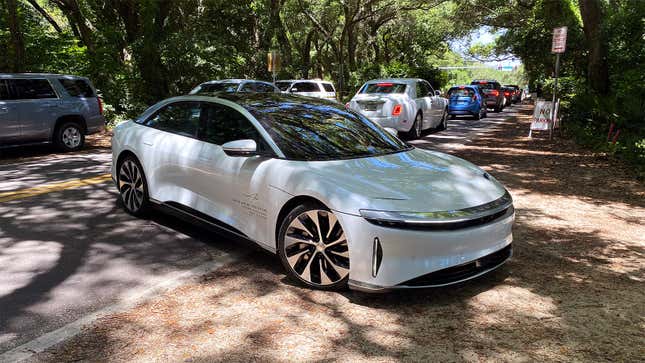
Those who have ridden in especially powerful electric vehicles often compare their acceleration to that of a spaceship. And while that’s perhaps as overused and unrelatable as a metaphor could be (if you have traveled in a spaceship, I’d like to hear your thoughts), it does convey an otherworldly notion of speed.
Last weekend at the Amelia Island Concours d’Elegance in Florida, the folks at Lucid were kind enough to take me for a spin in a pre-production prototype of its Air Grand Touring sedan. Since that ride I’ve been trying to come up with a more evocative description of the feeling of accelerating in that car, and I’m at a loss. It’s a weightless, yet planted sensation. It’s almost silent. It felt less like the car was propelling itself faster and faster, and more like it was tethered to an invisible slingshot that seemed to never stop pulling forward. Yeah, it pretty much felt like what I’d imagine it feels like to be a passenger in a spaceship.
Four years ago, before Lucid had even finalized the Air’s interior, my colleague Raph went for a ride in an engineering prototype. And although Lucid is in a far healthier position as a company today, with deliveries planned for the second half of this year, one thing that hasn’t changed in that span of time is the speed.

My ride in the Air lasted about 10 minutes. Derek Jenkins, Lucid’s Senior Vice President of Design and Brand, was behind the wheel. There were one or two moments where Jenkins and I had a bit of open road in front of us. We were going maybe 35 mph; he put his foot down, and in the space of maybe two seconds, all of a sudden we’d more than doubled our speed. No shakes, no rattles. “Totally composed,” just like Raph said back in 2017.
While the acceleration has remained a constant, just about everything else about this particular Air was different, better or near-final. For starters, this was a genuine prototype, and not a mule. It had a complete dashboard fitted with multiple displays and a mix of Alcantara, wood and wool. Jenkins cautioned it wasn’t production-caliber fit and finish, so if you see anything in these pictures that doesn’t look up to snuff, Lucid would kindly like you to keep that in mind. For what it’s worth, aside from a bit of stuttering from the infotainment system, the interior could have at least passed a visual test for production readiness.
It was a genuinely comfortable place to be. The seats were supple, the ride was compliant and smooth (even with the suspension set to Sport) and the legroom — my god, the legroom.

It’s been a regular point of our Lucid coverage over the past few years, but the startup’s designers have found inches of space for both front and rear passengers that you’re just not accustomed to seeing in a sedan like this. The Air isn’t a small car of course, but it matches the Tesla Model S’s overall length and wheelbase, yet provides rear-seat occupants with an additional two inches of legroom with the standard battery equipped. (The long-range Air raises the floor a bit, and only offers an additional four-tenths of an inch compared to what the Model S provides.)
I asked Jenkins how Lucid’s been able to maximize space in this way, and the short answer is across-the-board optimization. The motors and inverters are compact, as are the batteries. That careful physical packaging, coupled with the efficiency of the power management software Lucid’s developed, allows the Air to return more interior space to passengers than would be otherwise possible while still claiming healthy range and power (517 miles and 800 horsepower in the Grand Touring I rode in).

I also have to commend Lucid’s interior designers, who packed a total of four touchscreens into the car, without making it feel overwhelming. That’s partly because the largest display, which sits beneath the smaller central one above the dashboard, retracts when not in use, revealing more space to store things.

The infotainment system has a neat feature where items on the upper display can be swiped down to the larger bottom one; this is ideal for passengers controlling media and navigation. Lucid’s infotainment system is based on open-source Android (not to be confused with Google’s Android Automotive platform) and was a bit laggy in action, especially when trying to move items between the screens. Again, it wasn’t final, and Jenkins said the company has an announcement on that front coming soon.
Overall, it’s difficult not to come away impressed with the package Lucid is offering here. The Grand Touring I rode in starts at $139,000 though, so you’d expect to be nothing less than impressed. The base Lucid Air Pure starts at $69,900 after the government’s $7,500 tax credit, offering 480 HP and 406 miles of range. Personally, that sounds like more than enough for me — spaceship comparisons be damned.